Aquarium Conditioned
Female Bellus Angelfish
Genicanthus bellus
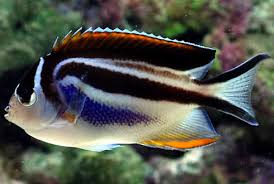
Identification:
The Female Genicanthus bellus is one of the prettiest species of swallowtail angelfish, and their small adult size makes them the most suited to aquarium life. Like all Genicanthus, G. bellus has very strong sexual color differences and some would argue that the female Bellus angelfish is even prettier than the male. The Bellus Angelfish (also called the Bellus Lyretail Angelfish, and Ornate Angelfish is one of the best reef safe angelfish. For those unfamiliar with this fish, the Bellus Angelfish is a relatively small (to seven inches), hardy and attractive angelfish with a generally peaceful disposition. Unlike most angelfish, they tend to leave invertebrates and corals alone, making them one of the few angelfish appropriate for a reef tank.
TankRecommendations:
Provide a 120 gallon or larger tank with large amounts of live rock for hiding and grazing on micro fauna.
Food and diet:
It is important to give it a varied diet in the aquarium but you don’t have to feed it zooplankton; various types of meaty food is known to work well. You can for instance make your own formula by mixing seafoods like shrimps, squid, mussels, clams etcetera with each other and adding some vegetables, e.g. spinach or green peas. Adding algae to the diet is recommended, e.g. fresh and marine algae + spirulina. Bellus angelfish will also like angelfish preparations and live food such as brine shrimp and mysid shrimp.
Level of Care:
Moderate
Acclimaton Time:
3+ hours
Reef Compatibility
: Reef Safe
Approximate Purchase Size:
Females: Small: 1" to 1-1/2"; Medium: 1-1/2" to 2-1/2"; Large: 2-1/2" to 3-1/2" XLarge: 3-1/2" to 4-1/2"
Small$339.99
Medium $369.99
Large $399.99
XLarge $469.99
Indian Ocean Pair $799.99
|
Aquarium Conditioned
Male Bellus Angelfish
Genicanthus bellus, Indian Ocean
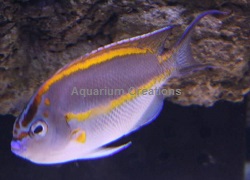
Identification:
The Bellus Angelfish from the genus Genicanthus is unusual in that they are not classed as true dwarf angels, yet they remain relatively small size. They also display a remarkable sexual dimorphism. Bellus Angelfish are ideal for a deepwater reef aquarium with lots of shady overhangs and crevices amongst the live rock. The Bellus Angelfish is a very active species that does require a good amount of space. Keep either singly, as a male-female pair, or one male with a harem of several females, but never house more than 1 male or with any other members of the Genicanthus genus. Several fishkeepers have spawned this species in the home aquarium, but there are no reports of the successful raising of fry.
TankRecommendations:
Provide a 120 gallon or larger tank with large amounts of live rock for hiding and grazing on micro fauna.
Food and diet:
It is important to give it a varied diet in the aquarium but you don’t have to feed it zooplankton; various types of meaty food is known to work well. You can for instance make your own formula by mixing seafoods like shrimps, squid, mussels, clams etcetera with each other and adding some vegetables, e.g. spinach or green peas. Adding algae to the diet is recommended, e.g. fresh and marine algae + spirulina. Bellus angelfish will also like angelfish preparations and live food such as brine shrimp and mysid shrimp.
Level of Care:
Moderate
Acclimaton Time:
3+ hours
Reef Compatibility
: Reef Safe
Approximate Purchase Size:
Medium: 2" to 3" Large: 3" to 4-1/4", XLarge: 4-1/4" to 5-1/2"
Medium$349.99
Large$399.99
XLarge $449.99
Indian Ocean Pair $799.99
|
Aquarium Conditioned
Annularis Angelfish
Pomacanthus annularis
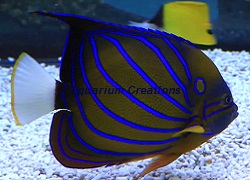
Description:
The Annularis Angelfish is also commonly called the Blue-ringed Angelfish or the Blue King Angelfish. Pomacanthus annularis is a beauty of a specimen both as a juvenile and as an adult. With a vibrant almost neon blue patterning of an upward curved bands that are on top of a golden background. Its common name comes from the bright orange, blue rimmed eyespot above the gill cover. This is one big angelfish, reaching almost 18” in the wild. A hardy angelfish, known to live for over 16 years in captivity. Interestingly the Annularis Angelfish make grunting noises when they are excited or distressed, which is unique to angelfish.
Tank Recommendations: Tank size is very important for the Annularis Angel to provide hiding places along with plenty of open swimming space. It should have a minimum tank size of 180 gallons, but optimally a 250 to 300 gallon tank is suggested. Be sure the tank is wide enough so this large angel can comfortably turn around. It makes it a good choice for the intermediate aquarist with a large tank and lots of live rock. These angelfish enjoy rock work arranged in a way that offers a few hiding places but also leaves open areas for swimming. Keep the water quality high and provide areas in the tank with some stronger currents. Also have good lighting for the angelfish's health. In the wild their bodies use sunlight to process vitamins from the foods they ingest. A tank with dim lighting can eventually leading to several maladies including blindness. This angelfish is best kept in a fish only community aquarium. It is semi-aggressive and can become quite belligerent, possibly bullying more passive tank mates such as butterflyfish, batfish, and trunkfish. It can be kept with another angelfish with different coloration and size, but only if the aquarium is large enough.
Reef Compatibility:Will nip at sessile invertebrates such as nudibranchs, corals, and clams.
Food and diet: Feed your fish 2 or 3 Times a Day. Feed only proper Angelfish foods that contain vitamin supplements. Large Angelfish must get vitamin b12, vitamin d3, vitamin e, beta carotene, riboflavin, biotin, and niacin. We use Ocean Nutritions Frozen sponge based food called "Angel Formula". Especially formulated for marine Angelfish Ocean Nutritions frozen food blend contains their primary natural food, namely marine sponges, combined with fresh seafood, oyster meat, scallop roe, fresh seaweed Spirulina, and Nori. We also use and recommend Hikari's Mega Marine Angel food. It includes Sponge, sea algae, sea urchin, sea worms, plankton, krill, shrimp, clam, mussel, squid, spirulina, algae extract, and cod liver oil. Both are excellent frozen foods.
Level of Care: Moderately hardy
Acclimaton Time: 3+ hours
Approximate Purchase Size:
Adult Medium: 2 1/2" to 4" Medium/Large 4" to 5" Large : 5" to 6" XLarge 6" to 7" Show 7" to 8"
|
Medium $449.99
Medium/Large $499.99
Large Ask
XLarge Ask
Show Ask
|
|
Aquarium Conditioned
Blueline Angelfish
Chaetodontoplus septentrionalis
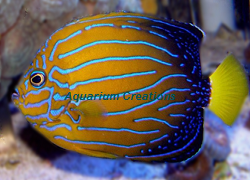
Description:
Blueline Angelfish are a highly attractive and colourful species that are endemic to tropical reefs around Japan and the Ryukyu Islands. As juveniles they are very dark brown to black and have a vertical yellow band that is even with their rear operculum; they also have yellow rear edges on their anal and dorsal fins, and a thin, yellow stripe on their face and lips. Their blue markings will become more abundant as they mature (at around 4-5") and their base coloration will morph to a yellow with a slight hint of green while their anal and dorsal fins remain dark. Blueline Angelfish are peaceful as juveniles, but once mature they can sometimes harass other tank mates with similar eating habits. Blueline Angelfish are a popular species, but they can be hard to find within the hobby; they are sometimes a special ordered fish. Email us if we show out of stock.
Tank Recommendations: Blueline Angelfish should be housed in an aquarium of at least 90 gallons and be provided with a sand substrate in addition to large amounts of live rock for grazing, shelter, and territory. They prefer to have adequate water movement, open swimming space, and quality water conditions; they should be provided with quality filtration to include biological, mechanical, and protein skimming.
As they mature they will establish their territory. We recommend Blueline Angelfish for community, FOWLR aquariums as they are known to snack on clam mantles, live corals, small invertebrates, and sponges.
Reef Compatibility:Will nip at sessile invertebrates such as nudibranchs, corals, and clams.
Food and diet: Feed your fish 2 or 3 Times a Day. Feed only proper Angelfish foods that contain vitamin supplements. Large Angelfish must get vitamin b12, vitamin d3, vitamin e, beta carotene, riboflavin, biotin, and niacin. We use Ocean Nutritions Frozen sponge based food called "Angel Formula". Especially formulated for marine Angelfish Ocean Nutritions frozen food blend contains their primary natural food, namely marine sponges, combined with fresh seafood, oyster meat, scallop roe, fresh seaweed Spirulina, and Nori. We also use and recommend Hikari's Mega Marine Angel food. It includes Sponge, sea algae, sea urchin, sea worms, plankton, krill, shrimp, clam, mussel, squid, spirulina, algae extract, and cod liver oil. Both are excellent frozen foods.
Level of Care: Moderate
Acclimaton Time: 3+ hours
Approximate Purchase Size:
Juvenile: Small 1" to 2" Medium 2" to 2 3/4" Changing: Small 1 1/2" to 2 1/4" Small/Medium 2 1/4" to 3 1/2" Adult: Medium 3 1/2" to 5" Large Adult: 5" to 7"
|
Small Juvenile $649.99
Medium Juvenile $649.99
Small Changing $749.99
Small/Med Chan $749.99
Adult 3 1/2" to 5" $799.99
Adult 5" to 7" $899.99
|
|
Aquarium Conditioned
Scribbled Angelfish
Chaetodontoplus duboulayi
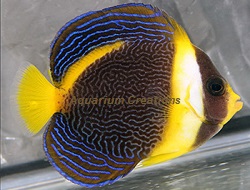
Identification: The Scribbled Angelfish also commonly known as Duboulay's Angelfish is a true beauty that hails from Australia. Very desirable and relatively easy to keep angelfish it is often the center piece of the aquarium. The Scribbled Angelfish derives its name from the scribbled pattern all over the body and large dorsal and anal fins. Most Scribbled Angelfish start life as females and undergo the change to male coloration when they reach roughly 4 to 6 inches in size. The Scribbled Angelfish males differ morphologically from the females. The males will usually have clearly defined horizontal dark blue 'scribbled' stripes down their sides and are longer in body, where the females will usually have more a randomized dark blue pattern on their sides and will usually be shorter in body length.
Tank Recommendations:
Do not keep the Scribbled Angel with aggressive tankmates as the may easily be bullied. Once adjusted to aquarium life, the Scribbled Angelfish will have its own territory. reach a maximum size of about 10 inches in the wild, smaller in the aquarium. They require an aquarium of at least 150 gallons to have enough room. As active swimmers the Scribbled Angelfish needs a longer tanks rather than a deep tank. The Scribbled Angelfish should not be kept with similar shape species unless the aquarium is VERY large, they would become aggressive to the similar species once established guarding its territory.
Reef Compatibility:Will nip at sessile invertebrates such as nudibranchs, corals, and clams.
Food and diet: Feed your fish 2 or 3 Times a Day. Feed only proper Angelfish foods that contain vitamin supplements. Large Angelfish must get vitamin b12, vitamin d3, vitamin e, beta carotene, riboflavin, biotin, and niacin. We use Ocean Nutritions Frozen sponge based food called "Angel Formula". Especially formulated for marine Angelfish Ocean Nutritions frozen food blend contains their primary natural food, namely marine sponges, combined with fresh seafood, oyster meat, scallop roe, fresh seaweed Spirulina, and Nori. We also use and recommend Hikari's Mega Marine Angel food. It includes Sponge, sea algae, sea urchin, sea worms, plankton, krill, shrimp, clam, mussel, squid, spirulina, algae extract, and cod liver oil. Both are excellent frozen foods.
Level of Care: Moderate
Acclimaton Time: 3+ hours
Approximate Purchase Size:
Small: 1" to 2" Medium: 2" to 3" Medium/Large: 3" to 4" Large: 4" to 5" XLarge: 5" to 6" Show: 6" to 7-1/2" |
Small Female $749.99
Medium Female $819.99
Medium/Large Female $929.99
Large Male $1099.99
XLarge Male $1199.99
Show Male$1299.99
|
Copyright 2021 Aquarium Creations Online
Photos are representative of each species. All marine life will be unique and variations should be expected, colors and sizes may vary.
*Guarantee Restriction: All of our livestock are guaranteed. However for one or more of these species, they may be marked with a *Guarantee Restriction. If it does, it means the specific animal may not handle stress from environmental conditions well. These stresses can include poor water quality, harassment from tank mates or confined aquarium conditions. When stressed, these species can lose the ability to ward off infection and disease. Other species may be listed as Restircted because they have such specialized feeding requirements that is difficult recreate in a aquarium and may succumb to mal nutrition.
|
|





